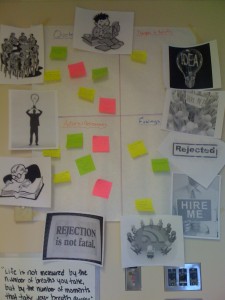Sometimes you can’t help but wonder who is out there reading our blogs. And whether the posts just end up attracting people who write about anti-wrinkle cream or anti-snoring pillows? But then faith is restored. Someone has responded seriously to your blog. They are excited about design thinking. And better yet they teach secondary school at Aldergrove Secondary School in Langley, British Columbia.
Meet Michael Cameron.
Mike is a UBC alum — BA in Sociology and Geography and a Bachelor of Education. He is obviously a game-changer. He is restoring my faith in the school system. Mike teaches English and something called AVID — Advancement Via Individual Determination. http://www.avid.org/abo_whatisavid.html
From what I understand, AVID is a system that is supposed to get students “college-ready”. Sounds like it is already a bit out-of-date. So when Mike came upon the d.studio blog, he decided it was time to try something new with those 70minutes chunks of time he has with his students five days a week.
Mike wrote me a note with some pictures about the activities of his class (stay tuned for a follow-up blog).
Mike writes: So we started out this year by doing a few activities that would introduce the students to some of the skills they would be using in the D-process. Then, we did the “Design a Wallet” activity from the Stanford K-12 Wiki. They seemed to be getting a feel for the process, and almost all of the students loved it and were highly engaged. The two that were not said to me, “why do I have to think? Can’t we just do a worksheet or something?” I told them they were finally getting their money’s worth at school, and they agreed that thinking was probably the purpose to education, though they rarely got a chance to do it.
What is exciting for me is that Mike is truly a design thinker — around figuring out how to engage his students in learning. He commented:
While design thinking can be used to meet Prescribed Learning Outcomes… it can feel a bit contrived. This is not really a problem for me, as I choose to focus on skills, which is where this process excels. It encompasses the whole of the so-called 21st century learning skills, and does so in a way that is relevant and meaningful for students (which is a major complaint about school, and fits with child psychology). While my first attempt was not exactly smooth, I was able to see the power of this process to engage students, teach them relevant skills, and get them to authentically think and collaborate.
Let’s hear it for teachers who can design think.

